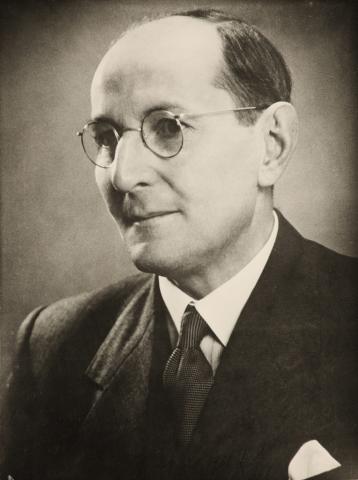Karl Garzarolli-Thurnlackh studied art history and history in Vienna and Graz, receiving his doctoral degree from the University of Graz in 1920. He began his career in 1919 as a librarian in the Institute of Art History in Graz and was recruited in the same year by the Styrian provincial government as a temporary assistant in the Graphics Collection at the Joanneum. In 1923 he became provisional director of the Picture Gallery, which was subsequently merged with the Graphics Collection, which he had headed since 1920, to become the Landesbildergalerie (provincial picture gallery). As permanent director, he made use of his professional network from 1924 and, with the support of the Landeskonservator Walter Semetkowski, saw the adoption in 1935 of a provincial constitutional law offering tax exemption to Styrian monasteries and abbeys in return for the transfer to the province of title to artworks. This resulted in the transfer of medieval artwork from St Lambrecht and Admont to the Joanneum. The two abbeys were seized after the annexation of Austria to the German Reich in 1938 and many artworks from their collections transferred to the Landesbildergalerie for safekeeping. As Garzarolli-Thurnlackh's criticism of the seizure of these properties and the provisional administration of the abbey by the Reichsstatthalter was interpreted as "treason", he was dismissed on 19 March 1939. After his rehabilitation by Josef Bürckel, Reich Commissar for the Reunification of Austria with the German Reich, he was reappointed from 30 January 1940 and, after the division of the Landesbildergalerie into the Alte and Neue Galerie in June 1941, became head of the Alte Galerie and sculpture collection. In this function he enlarged the collection, focusing on Gothic panel paintings and statues. He added numerous artworks expropriated from persecuted collectors in Vienna and Graz, such as Alphonse and Louis Rothschild, Oscar Bondy, Rudolf Gutmann, Valerie Eisler, Albert Pollak and Robert Spira. He travelled often to Vienna to select the works he wished to obtain from secured and seized collections. He is also known to have come to an arrangement with Bruno Grimschitz, director of the Österreichische Galerie in 1942 regarding the acquisition of the oil sketch Apotheosis of Saint Cajetan by Jakob Zanusi. Hans Herbst, head of the Dorotheum art department, had offered the work in 1940 to both directors after the seizure of the removal goods of August Blumberg and its transfer by Vugesta to the Dorotheum for sale. Garzarolli-Thurnlackh allowed first refusal to Grimschitz, who purchased the painting for the Österreichische Galerie. In 2009, it was recommended for restitution to Blumberg's heirs. As director of the Alte Galerie and sculpture collection, Garzarolli-Thurnlackh was responsible for putting artworks into safe storage. From 1938 he also acted as a court expert in general art in Graz. From November 1944 to the end of April 1945 he was a member of the Volkssturm.
After the war, he became temporary director of the Neue Galerie in the Joanneum in May 1945, since Hans Riehl, who had been its director since 1941, was forced to renounce the position for a time because of his former membership of the NSDAP. In October 1946 Garzarolli-Thurnlackh curated the exhibition Austrian Art from the Middle Ages to the Present with Fritz Novotny and Ignaz Schlosser at the Staatliches Kunstgewerbemuseum (State Art and Crafts Museum in Vienna now MAK). In the same year, he obtained his habilitation at the University of Graz and became director of the Albertina in Vienna. In 1947 he transferred to the Österreichische Galerie, where he was responsible for transforming it into a museum of Austrian art. He was also involved with restitution claims, such as those of Victor Ephrussi, Alma Mahler-Werfel and Robert Pollak and their legal successors. At the same time, like his predecessor Bruno Grimschitz, he continued to acquire high-quality artworks from the formerly persecuted Viennese collectors. In this way, in 1948 he obtained Klimt's Houses in Unterach on Lake Attersee and Birch Forest / Beech Forest from the Bloch-Bauer collection. They were restituted to the heirs of Ferdinand Bloch-Bauer in accordance with an arbitration court decision of 2006. In 1950 the lawyer Christian Broda informed Garzarolli-Thurnlackh of the storage of works from the former Heinrich Rieger collection with the Vienna transporter Spedition Hausner & Co., leading to negotiations with Rieger's heirs for the acquisition of some of the pictures by the Österreichische Galerie. Among them was Portrait of Wally by Egon Schiele, which had been restituted by mistake to Rieger's heirs but was in fact owned by Lea Bondi-Jaray, proprietor of Galerie Würthle in Vienna, and which became part of the Leopold collection in 1954 in exchange for other works. In 1953/54 Garzarolli-Thurnlackh was responsible for restructuring the collections in the Upper and Lower Belvedere, including the opening of the Museum of Medieval Art in the Orangery. He also set up a restoration workshop headed by the restorer and painter Wilhelm Kainz. He remained director until his retirement in 1959 and also lectured in general history of art in the Philosophy Faculty in Graz.

